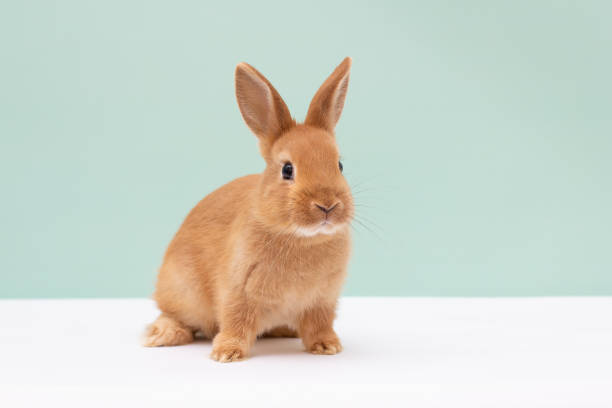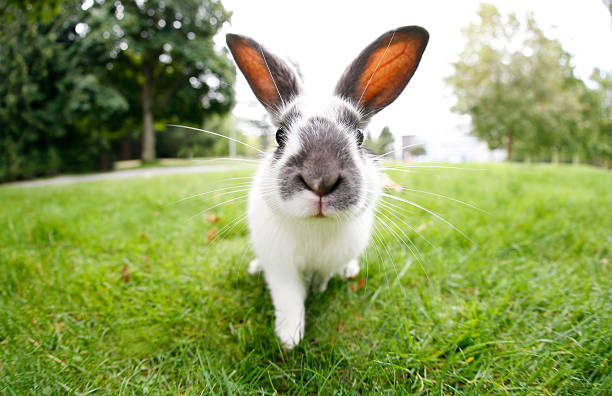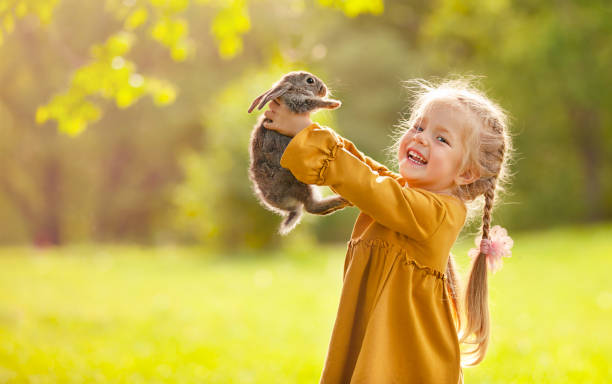5 Fun Facts About Rabbits
Rabbits need opportunities to socialise, plenty of space to run around and a variety of toys to chew. They also need hay and their teeth and nails need to be kept short.
Their eyes are located on the sides of their heads to allow them to see all around them – but they’re far sighted so can’t see very close up.
1. They have long ears
Rabbits have long ears to help them hear better. Their ear shape acts like sails, catching sound in all directions. Inside the ears is a chain of small bones called ossicles. They transfer the pressure of a sound wave from air (sound moving down the ear canal) to fluid (inner ear). They send this information to the rabbit’s brain so it can figure out what direction a noise is coming from.
The outer ears are also a good indicator of the rabbit’s mood. Upright ears are a sign of alertness, while flopped down or flattened ears indicate that the rabbit is relaxed and at ease.

Another reason that rabbits have long ears is to help regulate their body temperature. Their large ears contain a network of blood vessels that disperse heat and help the rabbit avoid heat stroke and hypothermia. Rabbits also use their ears to communicate, making a fluttering sound called ‘binky’ when they’re excited or happy. This is their way of communicating with other rabbits and humans alike! They may even thump their feet while binkying, which is probably their way of protecting their territory or warning others of danger.
2. They smell with their mouths
Rabbits need opportunities to socialize and lots of space and toys, otherwise they can become withdrawn and depressed. They also need to be able to gnaw on things such as timothy hay and cardboard oatmeal canisters – but only healthy items! They should never be gnawed on plastic, wire, or any other items that can cause damage or injury.
Those big bunny ears aren’t just for show – they act as finely tuned radar, allowing rabbits to hear sounds from up to two miles away. They can rotate their ears 270 degrees to pinpoint where sound (and potential predators) are coming from.

In the wild, rabbits are prey animals and need to be able to smell predators approaching. This helps them to escape in time before they are spotted by the predator. They can also sense changes in air pressure. This enables them to know when they are getting close to water, and can therefore avoid dangerously deep water. They also use their whiskers to measure the girth of openings and passages. They also have the ability to lick with their mouths, which can help them to find food or water in a pinch.
3. They ‘binky’ when they’re excited
Rabbits communicate in much subtler ways than other pets, but they do express emotions! Their ‘binky’, a cute little spin and jump, is a sign of excitement. They may also shake their heads when they are uncomfortable or having neurological issues such as vestibular disease.
They also make little oinking or honking noises when they are excited, and box or lunge to show they’re frightened. In the wild, this is their way of telling predators to get away!
They have a keen sense of direction, using cues from the sun and earth’s magnetic field to orient themselves. This is especially important for wild rabbits, who need to find their food and shelter. Domestic bunnies often use this sense of direction to navigate their homes, exploring new places and finding their favorite toys or hiding spots.
4. They’re crepuscular
Rabbits are crepuscular, meaning they’re most active at dusk and dawn. This is important because it allows them to hunt and graze without being a risk to their nocturnal predators or daytime prey.
This makes them a good pet for people who are nocturnal or night owls! Just make sure your rabbit is fed during the right time of day to avoid dehydration.

In the wild, rabbits live in large groups with strong hierarchies. They need opportunities to socialize and lots of space to play in, otherwise they can become withdrawn or depressed. Rabbits need other bunnies to keep them company, so if you decide to get one, make sure it’s neutered to prevent aggression.
Another interesting fact is that rabbits need to digest their food twice. Healthy rabbits leave hard, round droppings (called cecotropes) on the ground as a way of marking their territory. These are the first round of elimination, while soft, goopy caecotrophs are the second, expelled once they’ve been fully absorbed. They’re also used to regulate body temperature! This is why we often see rabbits licking themselves or each other.
5. They lick to show affection
Licking can be a sign of affection for rabbits. It’s how they show their love and trust for you as their pet. They also groom other rabbits and people as part of their instinctual social hierarchy. By grooming you, they’re establishing their place in your household and showing respect to those of higher rank.
Another way they show affection is by chinning. Just like a cat rubs their face on your leg, a bunny will put their chin against yours to claim you as theirs. They can also thump, which is their way of expressing excitement and happiness.
Loving a rabbit is very different to loving a cat or dog. They communicate in very different ways and are very shy. But, if you know how to read their body language, they will give you lots of love and attention in return. They may lick you, but they also have other silent ways to show affection such as binkying or simply sitting with you and relaxing. If you’re lucky, they might even kiss you! Aw, so cute!

